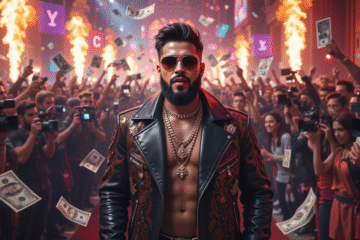Social media influencers have long been admired for their glamorous lifestyles, carefully curated posts, and seemingly perfect lives. From exotic vacations and luxury brand endorsements to millions of followers hanging onto every update, these online personalities appear to have it all. But as the world has learned, what goes on behind the filter often tells a very different story. In recent years, a wave of scandals has rocked the influencer world, revealing the chaotic, controversial, and at times shocking reality that lies just beneath the surface.
The term influencersgonewild has emerged to describe these very moments — times when popular creators fall from grace due to actions that contradict their polished image. Whether it is dishonesty, legal issues, exploitation, or emotional breakdowns, these incidents capture public attention and reshape how audiences view internet fame. This article explores the most notable real-life scandals involving influencers, what caused them, the fallout that followed, and what it all means for the future of social media culture.
The Rise of Influencer Culture and the Pressure to Perform
To understand the chaos behind these scandals, one must first understand the influencer industry itself. Influencers are essentially personal brands. They create content, build audiences, and monetize their popularity through ads, sponsorships, and merchandise. But this lifestyle comes with a high price. The pressure to stay relevant, engaging, and perfect at all times can push influencers toward dangerous decisions, both professionally and personally.
Unlike traditional celebrities, influencers are expected to be relatable and authentic. That paradox—being both aspirational and approachable—creates a constant tug-of-war between reality and performance. When that balance breaks, scandals erupt.
Scandal One: The Fake Charity Controversy
One of the biggest scandals to shake the influencer world involved a popular content creator who launched a charity campaign promising to help children in underprivileged areas. Thousands of followers donated, believing their money would make a difference. But weeks passed, and there was little transparency or evidence of how the funds were used.
Internet sleuths began investigating, and soon accusations of fraud surfaced. The influencer offered vague explanations and eventually deleted all related posts. Public trust collapsed, sponsors pulled out, and followers demanded refunds and accountability. This incident highlighted how easy it is for creators to misuse their platforms under the guise of goodwill and how difficult it can be for the public to verify the truth.
Scandal Two: The Private Life Exposed
Another instance of influencersgonewild involved a well-known couple on YouTube who portrayed their relationship as ideal and drama-free. Behind the scenes, however, the reality was far more complicated. A leaked audio clip revealed verbal arguments and manipulative behavior. The couple initially denied everything, but more evidence surfaced. Eventually, they separated and issued public statements.
Their downfall showed the danger of building a personal brand around a relationship. When private lives are turned into public content, any real conflict becomes part of the story. For audiences, it was a harsh reminder that even the most convincing online personas can be misleading.
Scandal Three: Offensive Past Content Resurfaces
In the age of digital footprints, no post ever truly disappears. Several influencers have faced backlash after old videos, tweets, or blog posts resurfaced, containing offensive jokes, racist remarks, or insensitive content. One famous lifestyle vlogger lost multiple brand deals after clips from their early career revealed repeated use of discriminatory language.
Though some fans accepted their apology, others questioned the sincerity and called for consequences. This sparked broader debates about cancel culture, accountability, and whether people should be permanently judged by their past actions.
Scandal Four: Mental Health and Emotional Burnout
Not all influencersgonewild moments are rooted in controversy. Some stem from emotional exhaustion. One Twitch streamer broke down on a live broadcast after being online for 18 hours straight. They cried uncontrollably, confessed to struggling with anxiety, and expressed regret over neglecting their well-being for content.
This moment was raw and deeply human. It started a widespread conversation about the mental health cost of online fame. Many viewers expressed concern and empathy, while others criticized the platform’s monetization model that rewards nonstop streaming and engagement.
Scandal Five: Lawbreaking for Views
In a bid to gain attention, a travel influencer was caught trespassing on restricted government property for a photo opportunity. They shared the experience proudly on social media, not expecting the backlash that followed. Authorities fined them, brands dropped partnerships, and the influencer’s reputation suffered major damage.
This is not an isolated case. Many influencers have been caught breaking rules—whether it is during a pandemic by ignoring health guidelines or violating copyright laws by using unlicensed music or footage. The pursuit of viral fame often leads to reckless behavior, blurring the line between creativity and illegality.
The Impact on Audiences
Scandals involving influencers hit differently than those involving traditional celebrities. That is because many followers feel personally connected to these creators. They watch their daily lives, comment on their updates, and even send direct messages. When a scandal breaks, it feels like a personal betrayal.
In some cases, audiences respond with anger. In others, they show sympathy and understanding. The influencer’s response often determines public opinion. A sincere apology and effort to grow can soften criticism, while defensiveness or silence usually makes matters worse.
The Role of Social Media Platforms
Platforms like Instagram, YouTube, and TikTok play a critical role in how these scandals unfold. Their algorithms reward attention, whether it is positive or negative. That means controversial content often gets pushed to more users, intensifying the situation.
At the same time, platforms are inconsistent in enforcing community guidelines. Some creators get banned for minor infractions, while others continue operating despite serious allegations. This inconsistency frustrates users and raises concerns about fairness, accountability, and transparency.
Lessons Learned and the Future of Influencer Culture
Despite the chaos, these scandals serve as important learning moments for both creators and followers. Influencers must recognize the responsibilities that come with their reach. Authenticity cannot be faked forever. Eventually, the truth finds its way online.
Audiences, on the other hand, must understand that influencers are not perfect role models. Admiration should be balanced with critical thinking. Just because someone is popular does not mean they are trustworthy.
Brands and platforms also have a role to play. Due diligence, stronger guidelines, and ethical partnerships are essential for building a healthier digital ecosystem.
Conclusion
The influencersgonewild phenomenon is not just about dramatic headlines or public shaming. It is about the growing pains of a new kind of fame—one that is constant, demanding, and built on digital illusions. Behind the filters and the hashtags are real people navigating complex worlds of success, scrutiny, and stress.
As influencer culture continues to evolve, so will the challenges that come with it. Whether these online personalities rise stronger or fall harder will depend on how they confront their own realities, and whether they choose transparency over perfection.



